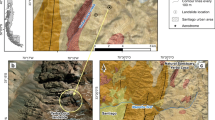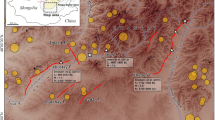Abstract
The major regions of Taiwan consist of high-relief terrain exposed to frequent typhoons and earthquakes. Recently, thousands of potential large-scale landslides have been delineated via remote sensing analysis and field surveys. However, little attention has been paid to the stability of colluvium, which is a potential hazard. This study investigated a paleo-rockslide site in detail and proposes a geological model to explain the failure mechanism. The studied area is in Jiasian, Southern Taiwan, and the site is a dip slope consisting of Miocene sedimentary rocks. Detailed topographic features, including residual slip surfaces, platforms, scarps, and colluviums, are identified using the slope map of a 1- m airborne remotely sensed digital elevation model. Platforms beneath the residual slip surfaces represent the topographic features of the paleo-rockslide, an interpretation validated by field works and core analysis. The platforms consist of a displaced rock mass (DRM) with a gentle bedding dip angle and interbedded structure that has been preserved. A geological model is established according to the data compiled; outcrops of DRM and colluviums on bedrock were delineated in the geological map and profiles. Outcrops of shear off, buckling, and compressive ridges within the alternating sandstone and shale are distributed at the toe of the residual slip surfaces. A geological model with identified topographic features is adopted to establish the geomorphological evolution of the site. A buckling-induced rockslide model in the dip slope of the interbedded layers is proposed, and potential future slope failure scenarios can be evaluated using the geomorphological evolution model.













Similar content being viewed by others
References
Agliardi F, Crosta G, Zanchi A (2001) Structural constraints on deep-seated slope deformation kinematics. Eng Geol 59(1–2):83–102
Agliardi F, Crosta GB, Frattini P, Malusà MG (2013) Giant non-catastrophic landslides and the long-term exhumation of the European Alps. Earth Planet Sci Lett 365:263–274
Allmendinger RW, Cardozo NC, Fisher D (2013) Structural geology algorithms: vectors and tensors. England, Cambridge University Press, Cambridge, p 289
Cardozo N, Allmendinger RW (2013) Spherical projections with OSXStereonet. Comput Geosci 51(0):193–205
Chang KJ, Taboada A, Chan YC (2005) Geological and morphological study of the Jiufengershan landslide triggered by the Chi-Chi Taiwan earthquake. Geomorphology 71(3–4):293–309
Chang KJ, Chan YC, Chen RF, Hsieh YC (2018) Geomorphological evolution of landslides near an active normal fault in northern Taiwan, as revealed by LiDAR and unmanned aircraft system data. Nat Hazard Earth Sys 18:709–727
Chigira M (1992) Long-term gravitational deformation of rocks by mass rock creep. Eng Geol 32(3):157–184
Chigira M (2011) The potential area of large-scale landslides, Scientific & Technical Publishing co., ltd, Taiwan, pp 227. (in Chinese))
Chigira M, Kiho K (1994) Deep-seated rockslide-avalanches preceded by mass rock creep of sedimentary rocks in the Akaishi Mountains, Central Japan. Eng Geol 38(3–4):221–230
Chigira M, Wang WN, Furuya T, Kamai T (2003) Geological causes and geomorphological precursors of the Tsaoling landslide triggered by the 1999 Chi-Chi earthquake, Taiwan. Eng Geol 68(3–4):259–273
Chigira M, Tsou CY, Matsushi Y, Hiraishi N, Matsuzawa M (2013a) Topographic precursors and geological structures of deep-seated catastrophic landslides caused by Typhoon Talas. Geomorphology 201:479–493
Chigira M, Hariyama T, Yamasaki S (2013b) Development of deep-seated gravitational slope deformation on a shale dip-slope: observations from high-quality drill cores. Tectonophysics 605:104–113
Corominas J (1996) The angle of reach as mobility index for small and large landslide. Can Geotech J 33:260–271
Crosta GB, Frattini P, Agliardi F (2013) Deep seated gravitational slope deformations in the European Alps. Tectonophysics 605:13–33
Francioni M, Stead D, Clague JJ, Westin A (2018) Identification and analysis of large paleo-landslides at Mount Burnaby, British Columbia. Environ Eng Geosci 24(2):221–235
Hsieh ML, Chyi SJ (2010) Late Quaternary mass-wasting records and formation of fan terraces in the Chen-yeo-lan and Lao-nung catchments, Central-Southern Taiwan. Quaternary Sci Rev 29(11–12):1399–1418
Hsieh ML, Lai LSH, Lin CDJ, Shyu JBH (2012) Late Quaternary landscape evolution and genesis of the 2009 catastrophic landslide in the Hsiao-lin area, southwestern Taiwan. Geomorphology 179:225–239
Hsü KJ (1975) Catastrophic debris streams (Struzstroms) generated by rockfalls. Bull Geol Soc Am 86:129–140
Hungr O, Evan SG (2004) Entrainment of debris in rock avalanches: an analysis of a long run-out mechanism. Geol Soc Am Bull 116:1240–1252
Jaboyedoff M, Oppikofer T, Abellán A, Derron MH, Loye A, Metzger R, Pedrazzini A (2012) Use of LIDAR in landslide investigations: a review. Nat Haz 61(1):5–28
Jakob M, Anderson D, Fuller T, Hungr O, Ayotte D (2000) An unusually large debris flow at hummingbird creek, Mara lake, British Columbia. Can Geotech J 37(5):1109–1125
Kuo YS, Tsai YJ, Chen YS, Shieh CL, Miyamoto K, Itoh T (2013) Movement of deep-seated rainfall-induced landslide at Hsiaolin Village during Typhoon Morakot. Landslides 10:191–202
Lee CT (2011) Geomorphological evolution and geology of the Tsaoling rockslide. J Chinese Soil Water Conservation 42(4):325–335 (in Chinese)
Lee CT, Dong JJ, Lin ML (2009) Geological investigation on the catastrophic landslide in Siaolin Village, Southern Taiwan. Sino-Geotechnics 122:87–94 (in Chinese)
Legros F (2002) The mobility of long-runout landslides. Eng Geol 63:301–331
Lin CW, Chang WS, Liu SH, Tsai TT, Lee SP, Tsang YC, Shieh CL, Tseng CM (2011) Landslides triggered by the 7 August 2009 Typhoon Morakot in Southern Taiwan. Eng Geol 123:3–12
Lin CW, Tseng CM, Tseng YH, Fei LY, Hsieh YC, Tarolli P (2013) Recognition of large scale deep-seated landslides in forest areas of Taiwan using high resolution topography. J Asian Earth Sci 62:389–400
Lo CM (2017) Evolution of deep-seated landslide at Putanpunas stream, Taiwan. Geomatics, Natural Hazards and Risk 8(2):1204–1224
Lo CM, Weng MC, Lin ML, Lee SM, Lee KC (2018) Landscape evolution characteristics of large-scale erosion and landslides at the Putanpunas stream, Taiwan. Geomatics, Natural Hazards and Risk 9(1):175–195
Scheidegger AE (1973) Physical aspects of natural catastrophes. Elsevier Scientific Publishing Company, Amsterdam-Oxford-New-York, p 289
Sung QC, Lin CW, Lin WH, Lin WC (2000) Explanatory text of the geological map of Taiwan, Chiahsien sheet, scale 1/50,000, Central Geological Survey, Ministry of Economic Affairs, Taiwan, pp 57
Tsou CY, Feng ZY, Chigira M (2011) Catastrophic landslide induced by typhoon Morakot, Shiaolin, Taiwan. Geomorphology 127(3–4):166–178
Wang WN, Chigira M, Furuya T (2003) Geological and geomorphological precursors of the Chiu-fen-erh-Shan landslide triggered by the Chi-Chi earthquake in Central Taiwan. Eng Geol 69(1–2):1–13
Wu JH, Lin WK, Hu HT (2018) Post-failure simulations of a large slope failure using 3DEC: the Hsien-du-Shan slope. Eng Geol 242:92–107
Zhang S, Zhang LM, Chen HX (2014) Relationships among three repeated large-scale debris flows at Pubugou Ravine in the Wenchuan earthquake zone. Can Geotech J 51(9):951–965
Funding
This research was funded by Contrast tfbc-1070401 from the Forestry Bureau, Council of Agriculture, Executive Yuan, Taiwan and MOST107-2625-M-009-001 from the Ministry of Science Technology, Taiwan.
Author information
Authors and Affiliations
Corresponding author
Rights and permissions
About this article
Cite this article
Yang, CM., Kang, KH., Yang, SH. et al. Large paleo-rockslide induced by buckling failure at Jiasian in Southern Taiwan. Landslides 17, 1319–1335 (2020). https://doi.org/10.1007/s10346-020-01360-3
Received:
Accepted:
Published:
Issue Date:
DOI: https://doi.org/10.1007/s10346-020-01360-3




